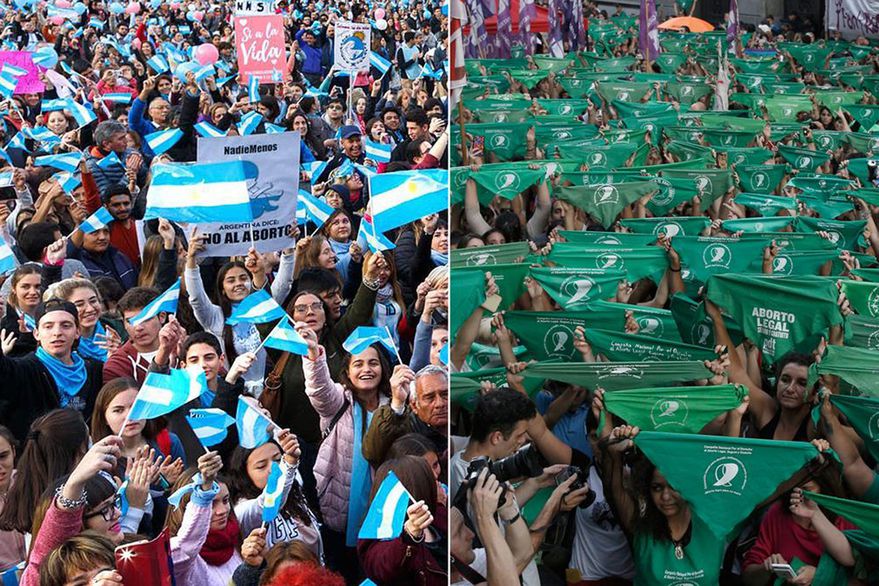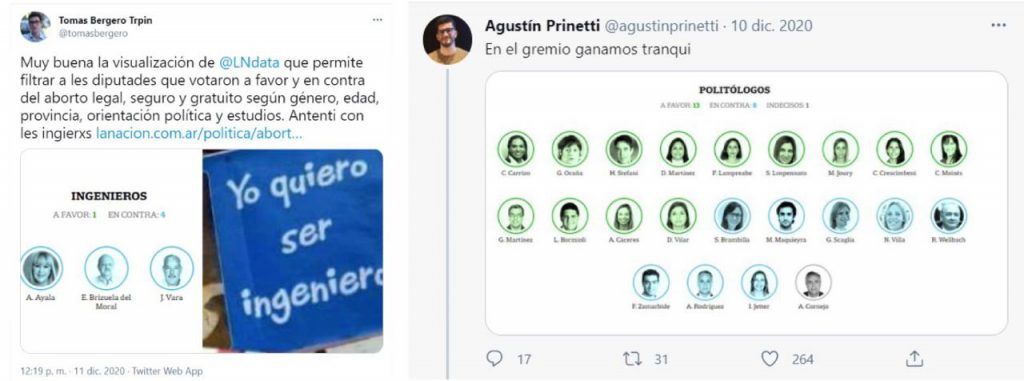
DESCRIPTION
The early hours of December 30th, 2020 marked an unforgettable day for Argentina. With the passage of the bill by the House of Representatives and in a historic decision -only comparable with the approval of divorce or same-sex marriage- Senate enacted the law legalizing abortion without cause up to the 14th week of pregnancy.
The complexity of the debate regarding voluntary interruption of pregnancy awakened a great interest in society, and it polarized in two positions related to colors: “the greens”, in favor of the legalization, and “the light-blues”, opposing to such position emphatically. And even each side took to the streets with manifestations and identification with symbolisms such as green or light-blue kerchiefs in their fists, backpacks or even in social media. Since the debate was activated in Congress in 2018 –where the bill was rejected precisely by the Senate (most conservative house)- until even the new voting day in 2020, audiences became eager of information about the legislative process, legislators and their positions with the passing of time. What’s more, in 2019 elections, it became a decisive factor when deciding to vote the future president and his congressmen.
From LA NACION we knew that the voting process would be covered by all national and even some international media. Therefore, we intended to carry out a differential coverage from the development of an interactive platform to satisfy audience needs and follow the voting process in real time. To that effect, we made an alliance with an NGO specialized in legislative matters: Directorio Legislativo.

The platform was launched 12 hours before the voting with the vote projections –each of the 72 legislators had been consulted– to obtain a first outlook. And then, as the session was being developed, we started verifying said positions as some senators, due to political pressures or other kind of pressures, decided to change their vote or abstain. Likewise, as time went by, the position of some legislators –named “the undecided” who had neither expressed their positions publicly nor informed their vote regarding this bill- started to become clearer. The development could be browsed intuitively by the audience and filtered according to topics such as: vote per party, vote per gender, vote according to academic background and according to age.

Moreover, once the voting process was finished, we generated value added for our audience comparing the votes in both houses (Senate and Representatives) under the mentioned filters.
STRATEGY & IMPACT
LA NACION’s strategy consisted in taking a turn off the beaten path, journeying far from the expected. To that effect, we resorted to team work between different areas of the newspaper and to a specialized civil society organization: Directorio Legislativo.
The information collected about each of the 72 legislators exceeded by far the classical topic regarding how they were going to vote in Congress, but it included matters such as academic background, age, province to which they belong, etc. This allowed us to count with a broader outlook and in a moment when our audience demanded each time more and better information we succeeded in satisfying such needs.
LA NACION’s coverage was trending topic in Twitter, where users highlighted the tool and the discoveries that resulted from the different information filters proposed to our audience. In a few hours, it became a consulting tool both for readers and congressmen and even for our newsroom journalists due to the clarity and the high level of detail of that tool.

Moreover, it was a unique development as LA NACION was the only national media that carried out such a meticulous and thorough count, and in real time regarding the voting projections of each legislator and their changes of position at the last minute. Another way of measuring the impact is through the metrics: the note had an aggregate number of 252.777 pageviews, something historic for our site. Also the average reading time was 8:36 minutes, which is very high in comparison with the one from the site.
As well as in many other projects, the key to overcome difficulties consisted in transversal work between professionals from different areas: journalists, data analysts, producers, designers and programmers to develop in record time a high quality product to meet the needs of our audience.
LA NACION was, undoubtedly, the media that reflected the coverage most profoundly and with the highest quality, and it has been acknowledged even by journalists from the competition.
HOW MANY PEOPLE WORKED ON THIS PROJECT OR WHAT IS YOUR BEST ESTIMATE?
A total number of 16 persons worked in this Project. Eleven of them were assigned by LA NACION newspaper, among programmers, parliamentary journalists, journalists mastering data journalism and designers; and five of them were assigned by Directorio Legislativo NGO.
WHAT WAS THE TOTAL PROJECT BUDGET OR YOUR BEST ESTIMATE?
Productions were carried out by LA NACION teams with no need of an extra budget.